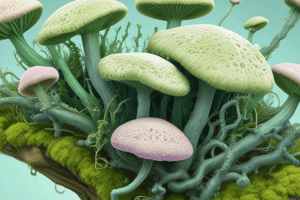Podcast
Questions and Answers
What role do green unicellular algae play in sewage treatment plants?
What role do green unicellular algae play in sewage treatment plants?
- Providing oxygen for bacteria (correct)
- Killing bacteria
- Decomposing sewage
- Removing heavy metals
What is one of the beneficial uses of algae in the environment?
What is one of the beneficial uses of algae in the environment?
- Destroying crops
- Causing harm to marine life
- Indicating environmental change (correct)
- Polluting the air
What is a potential source of bio-fuel from algae?
What is a potential source of bio-fuel from algae?
- Lipid content (correct)
- Chlorophyll
- Carbohydrates
- Cell walls
Which type of algae is used in the production of limestone?
Which type of algae is used in the production of limestone?
What is the percentage of protein content in Spirulina sp?
What is the percentage of protein content in Spirulina sp?
What is a nutrient found in algae that is beneficial for humans?
What is a nutrient found in algae that is beneficial for humans?
Which type of algae is used as a fertilizer in paddy fields?
Which type of algae is used as a fertilizer in paddy fields?
What is one of the medical uses of Sargassum sp?
What is one of the medical uses of Sargassum sp?
What is the industrial use of Laminaria sp?
What is the industrial use of Laminaria sp?
What is one of the industrial uses of algae?
What is one of the industrial uses of algae?
Flashcards are hidden until you start studying
Study Notes
Algae Diversity
- Algae are organisms that are neither plants nor animals, belonging to the Kingdom Protista or Prototista.
- They can be found in terrestrial and aquatic habitats, including freshwater and marine environments.
- Algae come in many different forms, shapes, sizes, and colors, and can exist on their own or grow on the surfaces of other organisms.
Habitat
- Small free-floating algae are known as phytoplanktons.
- They can be found in aquatic habitats, including semi-permanent pools, ponds, lakes, streams, and ocean shorelines.
- In terrestrial habitats, algae can be found on rock, wood surfaces, and in symbiotic association with fungal species, known as lichens.
Divisions of Algae
- Algae are grouped into three divisions based on their pigmentation:
- Rhodophyta (Red Algae)
- Phaeophyta (Brown Algae)
- Chlorophyta (Green Algae)
Characteristics of the Three Divisions
- Chlorophyta (Green Algae):
- Made up of unicellular, colonial, and multicellular forms
- Mostly found in freshwater, with some marine forms
- Reproduce asexually and sexually, with biflagellated gametes
- Rhodophyta (Red Algae):
- Multicellular, mostly marine groups
- Cells are non-flagellated
- Alternation of generation is common
- Chlorophyll is masked by red pigments
- Phaeophyta (Brown Algae):
- Multicellular, mostly marine groups
- Found in intertidal zones
- Chlorophyll is masked by brown pigments
- Alternation of generation is common
Algal Structure
- Algae exist in various forms, including:
- Non-motile unicellular (sedentary)
- Unicellular motile
- Motile coenobial form
- Non-motile coenobial form
- Filamentous form (branched and unbranched)
- Thalloid form
- Special forms
Life-Cycle of Algae
- Algae reproduce via three different modes:
- Vegetatively (e.g., fragmentation, fission)
- Asexually (e.g., by different spores)
- Sexually (e.g., by gametes)
- Green algae reproduce asexually and sexually
- Sexual reproduction involves biflagellated gametes
- Alternation of generation is common in Brown and Red algae
Mode of Nutrition
- Algae are capable of synthesizing their own food from inorganic substances using light or chemical energy
- They are autotrophic organisms, using light as the source of energy to prepare their food
- They are photoautotrophs, meaning they use light to synthesize their own food
Economic Importance of Algae
- Algae are a link in the food chain, providing energy for other organisms
- They are useful in fish culture, serving as a source of feed for fish
- Algae can be harmful in large quantities, causing harmful algal blooms that can have negative impacts on humans, marine and freshwater environments, and coastal economies
- They are used in sewage treatment plants to provide oxygen for bacterial decomposition
- They are used in the petroleum and gas industry, with some varieties having high lipid content serving as a source of bio-fuel
- Algae form extensive deposits of limestone, accumulating calcium carbonate in their cell walls
- They are used as food, providing carbohydrates, vitamins, and inorganic substances
- Algae are used as fodder, with some species being used as stock feed
- They are used as fertilizer, with some species having nitrogen-fixing capabilities
- Algae are used in medicine, with some species being used to treat goitre and other glandular problems
- They are used in industrial applications, such as the production of agar, kelp, and algin.
Studying That Suits You
Use AI to generate personalized quizzes and flashcards to suit your learning preferences.




